Simple, Yeasted Homemade Naan, A Step-by-Step Guide {Video}
This post may contain affiliate links. Please read my disclosure policy.
Naan is one of the simplest bread recipes you could make. There is no kneading, which allows the dough to come together very quickly, and after a short rise, you simply divide, roll, and griddle. The dough is so soft and tender thanks to yogurt, and a brush of melted butter out of the skillet makes them completely irresistible!
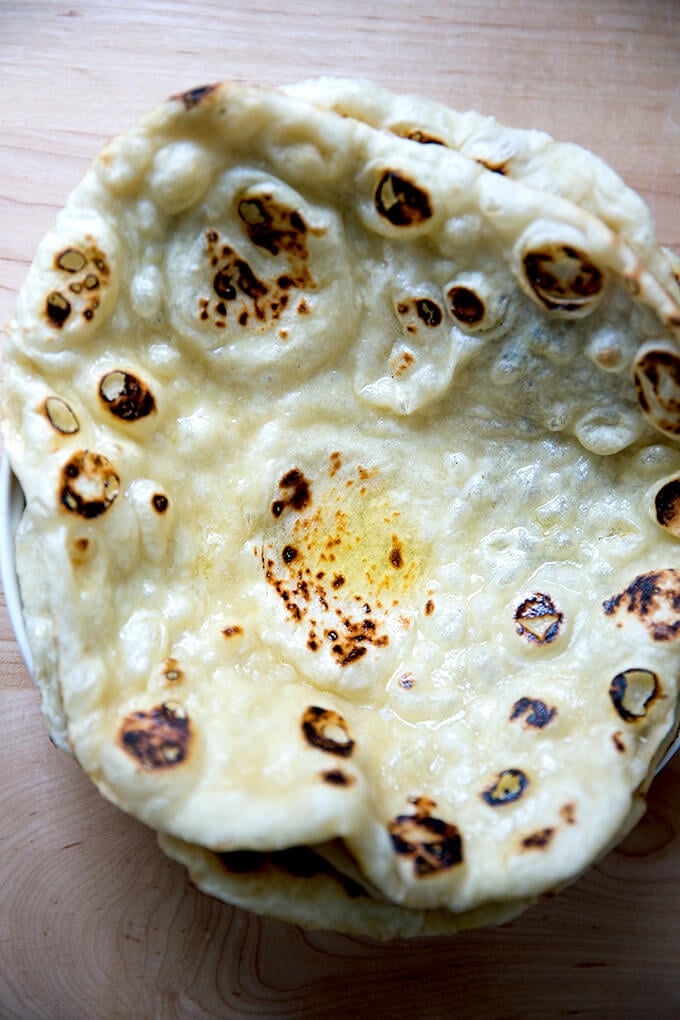
My friend Deb messaged me last week with a few questions about making naan. I hadn’t made it in ages, and having recently revisited and loved making homemade tortillas, I felt up for a little project.
As you might imagine, if you search the internet for “naan”, you will find all sorts of recipes, nearly all of which include yogurt, some of which include oil, and others that include eggs.
But what has always perplexed me about naan recipes is the variety of leavening agents. I’ve seen recipes that call for:
- baking soda alone
- a combination of baking soda and baking powder
- a combination of yeast, baking soda, and baking powder
- yeast and baking powder
- yeast alone
Though I knew in my heart I would likely go with a yeast-only naan, I felt the need to explore a little bit. Would there be any reason to include a chemical leaven (baking soda or powder) with yeast? Any reason to use all three leavening agents? Any reason to forgo yeast altogether?
Before I share my results, shall we quickly review the difference between baking soda and baking powder? This is something I will never ever commit to memory, but I enjoyed the recent refresher. This Bob’s Red Mill article was particularly helpful and interesting.
Baking Soda vs. Baking Powder
- Baking soda is a base and reacts with acid (vinegar, yogurt, buttermilk), which produces gaseous carbon dioxide bubbles, which causes baked goods to rise.
- Baking powder is made of baking soda (a base), cream of tartar (an acid), and sometimes cornstarch. Most baking powder is double-acting, meaning CO2 will be produced at two different phases: first when the batter is mixed (due to the liquid in the batter activating the base and acid), then when the dough is placed in the oven (due to the acid being both hot and wet).
- Baking soda is 4 times as strong as baking powder.
- Batters made with baking soda should be baked shortly after mixing because the gaseous bubbles dissipate quickly.
- Batters made with baking powder can be stored for longer (even in the fridge overnight).
Naan Experiments
- I started with the Bread Toast Crumbs dough ratio: 2 cups flour, 1 teaspoon salt, 1 teaspoon instant yeast, 1 cup liquid.
- After several experiments, I found a mix of 1/2 cup Greek yogurt and 1/2 cup + 2 tablespoons water created a perfect dough: not too wet, not too stiff. Interestingly, the liquid (yogurt + water) and the flour here weigh the exact amount: 256 g.
- I omitted the sugar. This is something I’m doing more and more with my breads. So many recipes call for a small amount (2 to 3 teaspoons), and I suspect this is mostly to help activate the yeast, especially when using active-dry yeast. With instant yeast, sugar isn’t necessary, and I don’t think such a small amount imparts enough flavor in the dough to warrant including.
- I tried various combinations of baking soda, baking powder, and yeast, and I liked all of them, but, especially when baking soda was in the mix, I could detect a slight metallic taste in the dough. It wasn’t a bad taste, but it was noticeable. I also found the baking soda doughs burned more easily.
- The baking powder-yeast dough compared to the yeast-only dough were nearly identical — similar air bubbles in the pan, similar dough texture, similar flavor — so, in the end, I stuck with yeast alone as a leaven.
Friends, making naan is SO much fun. The dough takes no time to whisk together, rises relatively quickly (just over an hour), and each naan cooks for a minute and 30 seconds stovetop.
I would be happy eating naan and naan alone — sprinkled with sea salt it is irresistible — but it is an especially nice accompaniment to many a stewy dish, namely lentils and curries. Here are a few ideas:
- One-Pot Thai Chicken Curry
- Curried Lentils with Kale and Coconut Milk
- Black Lentils with Spinach and Labneh
- Curried Chickpeas with Cauliflower
PS: Easy, Homemade Pita Bread Recipe
Here’s the play-by-play: Combine 2 cups flour, 1 teaspoon instant yeast, and 1 teaspoon kosher salt in a large bowl. As always, a digital scale is best for measuring. (Weight measurements included in the recipe)
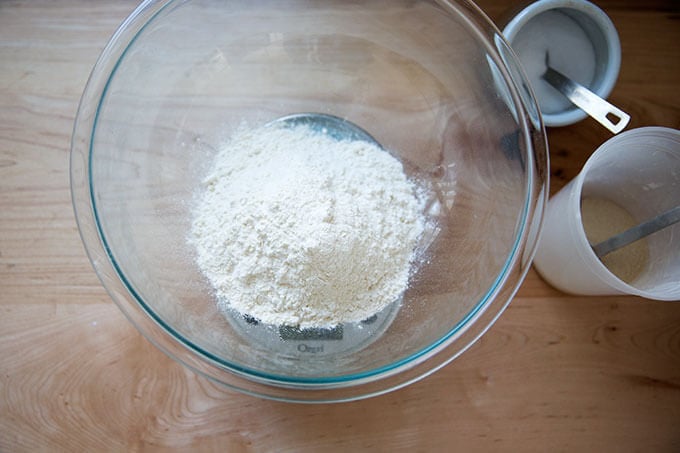
Combine 1/2 cup Greek yogurt with 1/2 cup + 2 tablespoons boiling water.
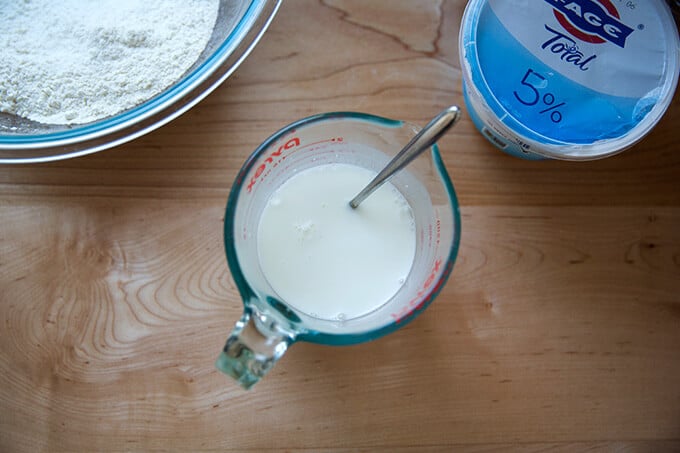
Pour the liquid into the dry ingredients, and stir with a spatula to form a ball. You’ll likely need to knead with your hands for about a minute to get the dough to come together (see video for guidance.)
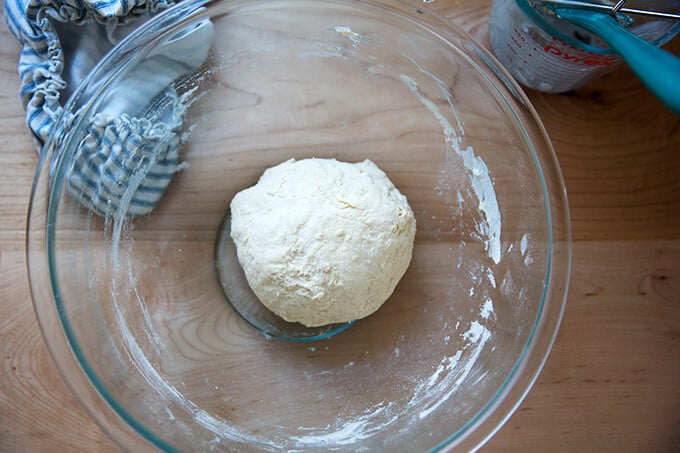
Cover the bowl and let it rise in a warm spot for about an hour and 15 minutes, or until the dough looks slightly puffed.
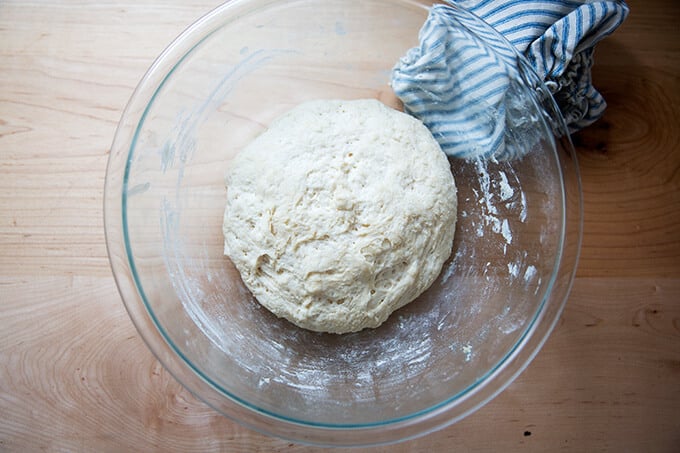
Turn the dough out onto a floured work surface.
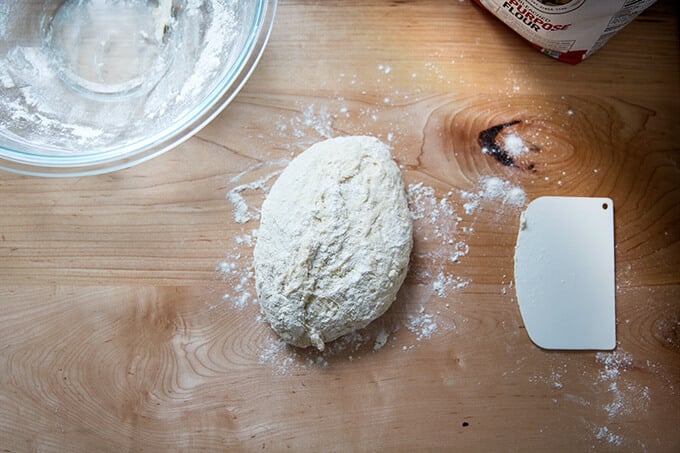
Divide the dough into 4 portions.
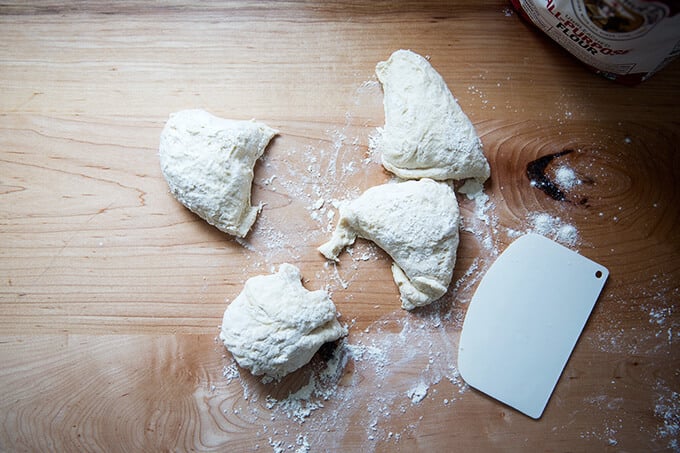
Ball each one up.
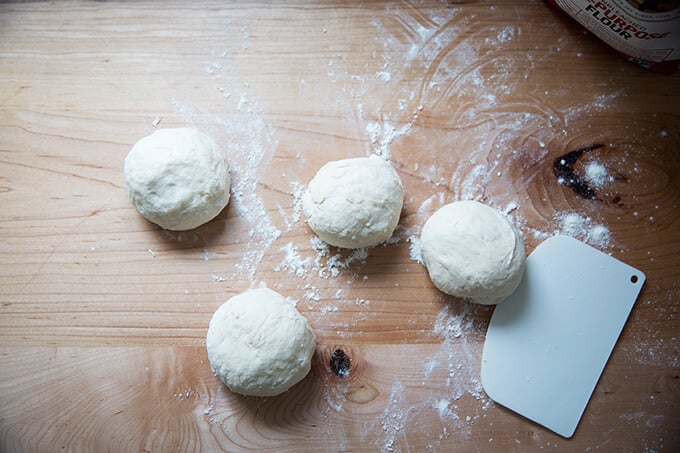
Roll each into an 8- or 9-inch round.
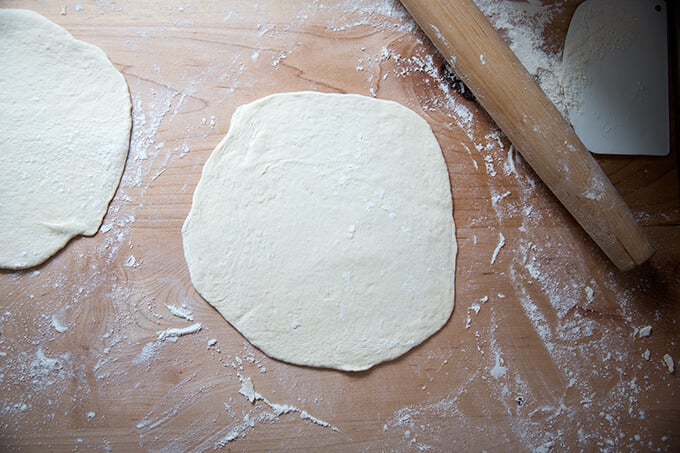
Heat a cast iron skillet over high heat till it’s very, very hot. Place one round in, cover, and cook for 1 minute. Uncover, flip, and cook for 30 seconds.
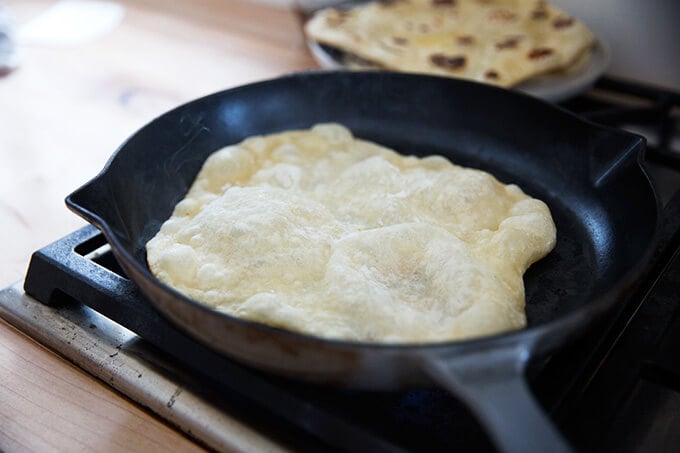
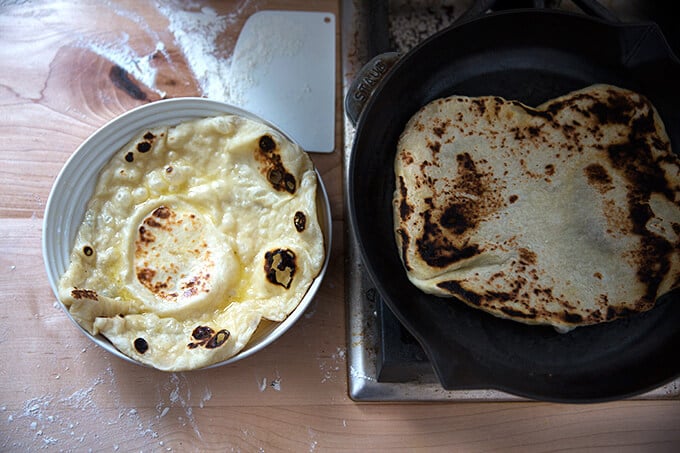
Brush each round with melted butter once it is out of the pan.
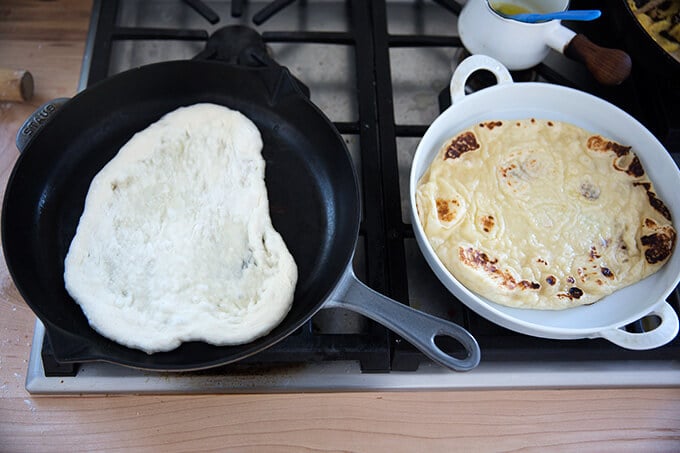
Stack the cooked, buttered naan on a plate or platter and cover with a towel till ready to serve.
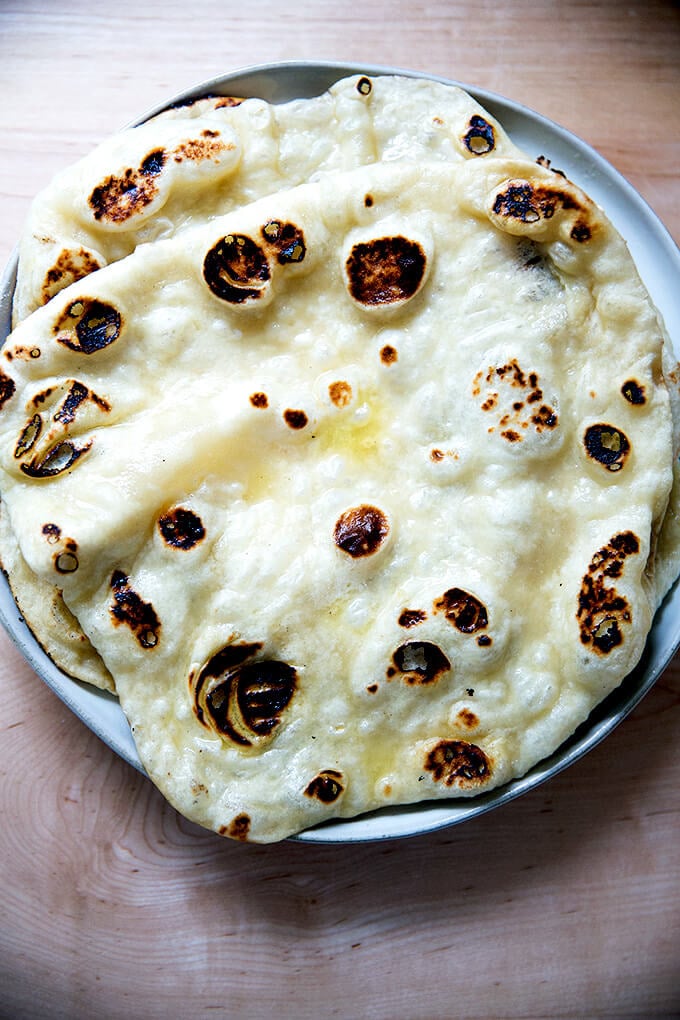
Friends, these are sooooo yummy ….
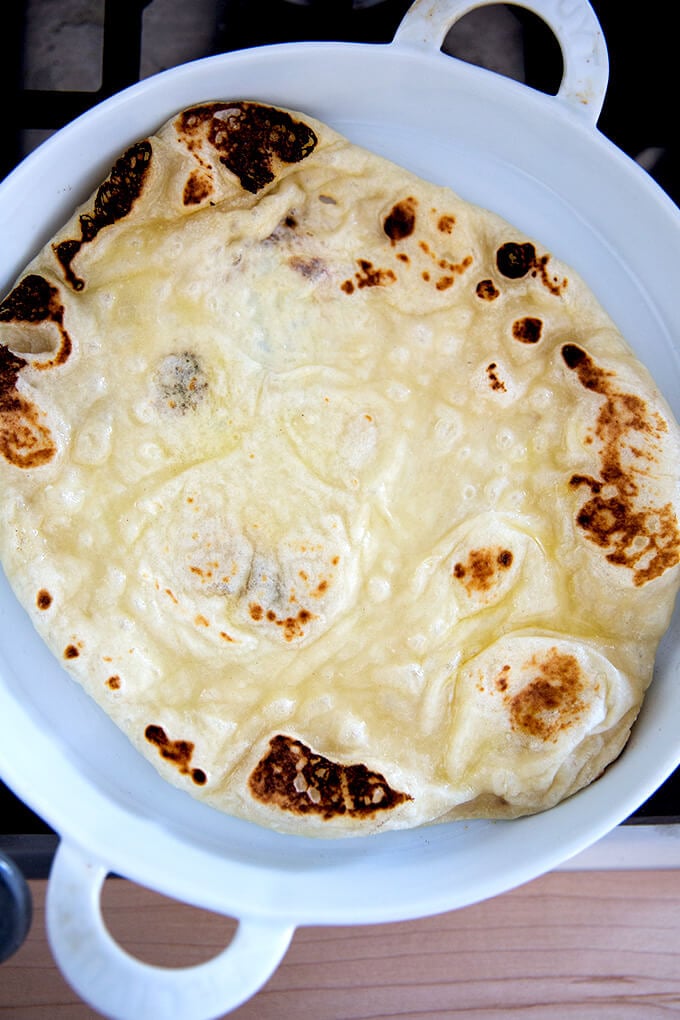
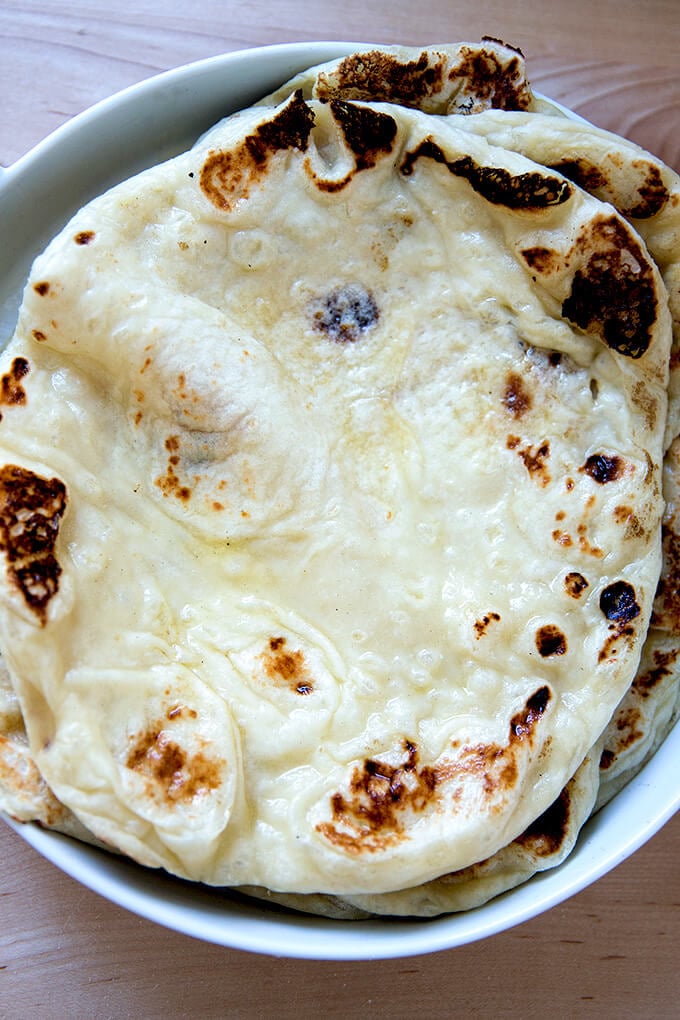
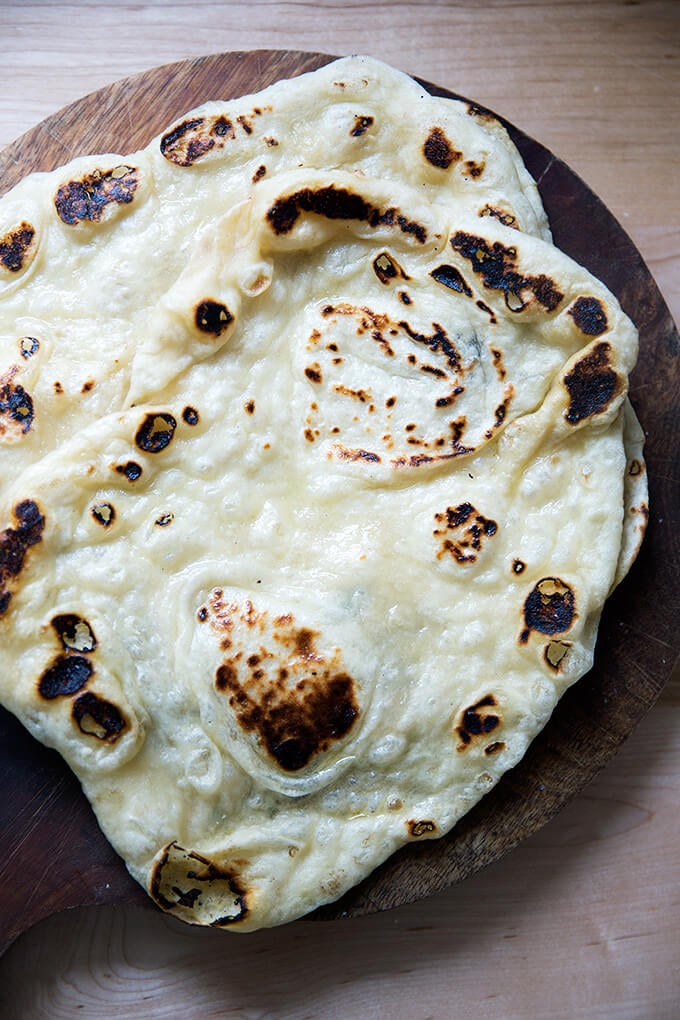
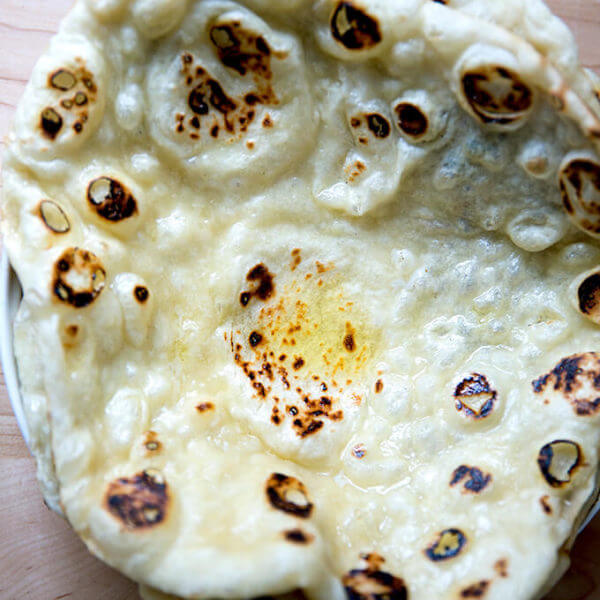
Simple, Yeasted Homemade Naan
- Total Time: 1 hour 55 minutes
- Yield: 4
Description
Notes:
- As always, for best results, use a digital scale.
- To create a warm spot for your dough to rise: Preheat your oven for 1 minute, then shut it off. Note: Any temperature is fine, but the oven is only on for 1 minute total. You don’t, for example, want to get your oven up to 350ºF and let it heat there for a minute. The oven will likely not rise about 100ºF. You just want a cozy, draft-free spot for your bread to rise.
- Notes for making dough ahead of time: Once the dough is mixed, pour a thin layer of oil over top and turn the dough to coat. Cover bowl, stick in the fridge, and keep it there till about an hour before you are ready to bake the following day. Divide the dough, ball it up, and let it rest for about an hour before rolling out.
- Interestingly, the weight of the flour and the weight of the liquid (water + yogurt), are identical here: 256 g each. I suspect, if you use buttermilk or regular yogurt as long as you keep the total weight of the liquid close to 256 g, the naan will turn out just fine.
Ingredients
- 2 cups (256 g) all-purpose flour
- 1 teaspoon (5 g) kosher salt
- 1 teaspoon (4 g) instant yeast
- ½ cup + 2 tablespoons (136 g) boiling water
- ½ cup (120 g) Greek yogurt
- 2 tablespoons melted butter, for brushing (I use salted)
Instructions
- In a large bowl, whisk together the flour, salt, and instant yeast. In a medium bowl or a liquid measure, stir or whisk together the water and yogurt. Add the yogurt mixture to the flour mixture and stir to combine with a spatula. When the mixture becomes too stiff, knead with your hands for about a minute or until the flour is incorporated and you have a sticky, wet ball. Cover with a towel or cloth bowl cover, and let rise in a warm spot for 1 to 1.25 hours. (See notes above for creating warm spot. See notes above for making dough ahead of time.)
- Turn dough out onto a lightly floured work surface. Divide into 4 equal portions, then shape each into a ball. Let rest for 5 minutes.
- Heat a large skillet (something like cast iron is great) over high heat. You want it very, very hot. Using a rolling pin dusted in flour, roll one ball into a thin large round or oval (8- to 9-inches in diameter, roughly), using flour as needed to prevent sticking. Repeat with another round. (I like to start with 2 rounds rolled out; then I roll the remaining 2 while the first 2 are cooking.)
- When the skillet is very hot, transfer rolled out round, dusting off excess flour if possible, to the skillet. Cover. Cook for 1 minute. Close to the end of the minute, you’ll hear the pan hissing a bit … this is a good sign. Flip, and cook for another 30 seconds uncovered. Transfer to a plate and brush the top lightly with melted butter.
- Repeat this process with the remaining dough balls. You may have to adjust the heat as you go. If too much flour is burning in the skillet, turn it off, carefully wipe it out with a dish cloth, then crank the heat back up. As the naan emerge from the skillet, stack them on top of one other in a shallow bowl or plate. Cover with a tea towel to keep warm.
- Prep Time: 1 hour 45 minutes
- Cook Time: 10 minutes
- Category: Bread
- Method: Yeast
- Cuisine: Indian
This post may contain affiliate links. Please read my disclosure policy.

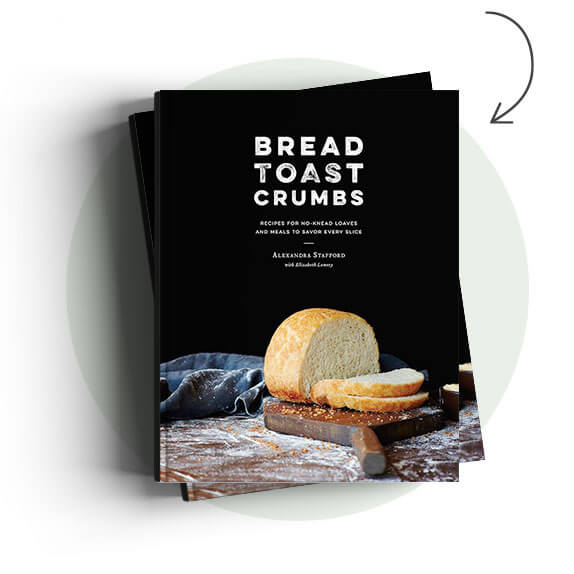

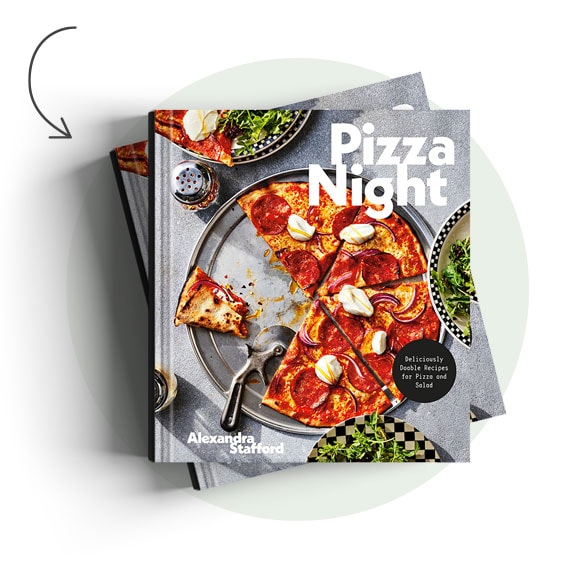
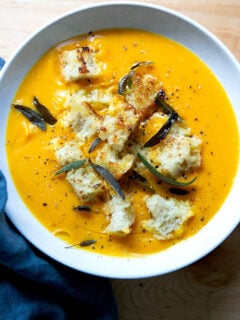
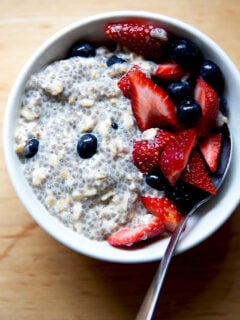
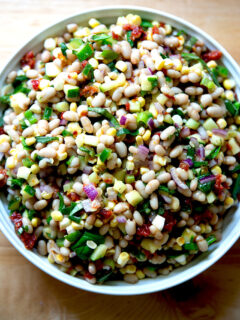
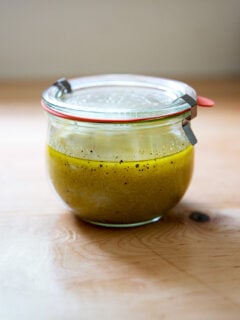
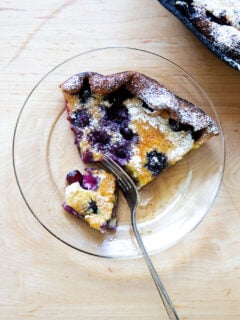
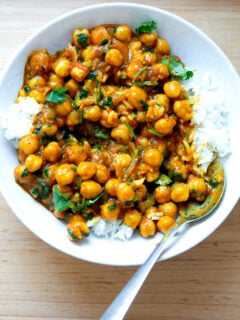

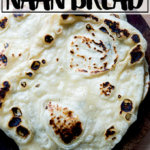
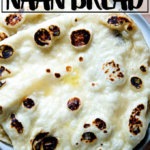
227 Comments on “Simple, Yeasted Homemade Naan, A Step-by-Step Guide {Video}”
Hi, could I make a gluten free version of this and would the measurements be the same in terms of GF flour? Any need for Xantham gum? I struggle to make tasty gluten free naans. Thanks
Hi Heather! I think it’s probably best to use a gluten-free mix such as Cup for Cup that already has xanthan gum in it. I don’t have any experience making gf naan, however, so I don’t know how to advise. The best gluten-free breads I make have more of a batter-like consistency in their unbaked form, so I don’t know how that would work for naan.
Simple recipe wit no uneccessary ingredients like sugar, egg, milk, oil- just NOT NEEDED. Super easy to mix in a few minutes. I used 0%fat Fage.
Like her warning about excess flour and the smoking it causes in your kitchen. I use little and dust off w pastry brush before placing on super hot cast iron griddle. I like 6 pieces better than 4. I have melted butter w garlic and parsley heated and slather on w silicone brush after each cooks- Have your fan on- i usually make flatbreads when mild weather and i can have my porch door open and back door open as I fear rhe smoke detector will go off. They stack and keep warm quite a while so I wait until cool, wrap in wax paper the place in ziplcock. Nigella seed looks pretty also in the garlic butter parsley mix.
Great to hear, thanks for writing and sharing your notes, Teresa!
Hi Ali! Have you tried making these in the oven like pita? I’ve made this recipe before with great success, but I double it for our family, and the oven seems like it might be easier than a skillet! Thanks!
I have not tried, Kate, but I think it’s worth a shot. I would start with one or two so that you don’t ruin the whole batch if you aren’t satisfied with the results. Good luck!
I tried baking them this week, and it turned out OK. I used a Lodge cast iron pizza pan, at 450 degrees for 3 minutes a side. I think they needed more time and possibly higher heat. I missed some of the charring that you get from a skillet, but overall, it wasn’t bad. I’ll definitely try again.
i am going to finally try this this weekend. have you ever doubled the recipe? any reason that i should not? thank you for all of your amazing recipes!
No reason to not double! Go for it 🙂
Hi Ali, I plan to try your Naan Recipe this weekend ( like the fact that the ingredients are simple) , BUT substituting APF with Unbleached BF, and baking it in an OONI oven; doing a 24-36 hr cold proof and using Vegan Yogurt ( dairy free). Any thoughts or advise and wondering if you have tried your recipe in the Ooni. TY.
Hi! What a fun experiment! I have not tried baking this naan in an outdoor oven, but I imagine it will work great. I would just watch it like a hawk because it will cook much faster and will potentially burn too. You might need to bake one as a test and then adjust the timing and temperature from there. Good luck!
HI Ali
first of all I make these naans religiously – so good! didn’t you have a sourdough discard version? i thought I saw one at some point …but can’t locate
I’m going to just toss some in and see what happens, 1/2 cup – 120g. Please let me know if you have any recipe.
thanks so much
Hi Julie! I have a sourdough flour tortilla recipe but not one for naan. I think using 1/2 to 1 cup of discard in place of an equal amount (by weight of flour and water) will work well here.
Perfect, perfect, perfect (and delicious & easy) Naan! Just like your pita bread recipe, no reason not to do this more often, like regularly. I doubled the recipe and froze leftover breads. Thank you!
Great to hear, Paul! Thanks so much for writing. It’s the best feeling having a stash of homemade naan or pita (or any homemade bread!) in the freezer.
Thos naan bread is so easy and so fresh compared to the stuff you buy in the store. Made some red lentil soup to go with the naan….cant wait for dinner!
Yay! Great to hear, Tracy 🙂 🙂 🙂 Nothing better than soup + bread.
Hi! This is my go-to naan recipe. I just love it so much! Question: I am entertaining this weekend and was hoping to make some naan ahead of time. Do you have any recommendations for the best way to revive the finished naans 1-2 days later? Or is this a terrible idea? Thank you!
Hi! I wouldn’t make them much more than 1 day in advance. They just lose their freshness. If you make them one day in advance, simply reheat them in the oven at 350ºF for 15-20 minutes or so. Good luck!
Hi, Ali. Thanks for the recipe. I have a whole tub of plain full fat yogurt on hand I’d like to use up. Have you tried regular yogurt instead of Greek? Making these right with your black lentils and spinach recipe 🙂
Hi! It should work fine especially if you are measuring by weight. If the dough feels wetter, I’d just sprinkle in a little more flour until it reaches the right consistency. Such a fun meal!
Thanks, Ali. I did use regular yogurt and all was delicious. I did not add the two extra tbs of water and the dough was perfect.
Great to hear! Thanks for reporting back 🙂
Oooh I love this recipe!. The naan bread was so soft and moorish. Very easy to make and will make again. I served the bread with my favourite dahl recipe. Perfect. Thanks again Ali 🙂
Great to hear, Sharon 🙂 Thanks so much for writing.
I made your naan recipe yesterday. I have been baking bread and occasionally naan for years and this formula and method was the easiest and yielded the best results that I have ever had! I replaced half of the flour with whole wheat without having to make any other changes. The naan was so good! Thank you.
Oh yay! Great to read all of this, Caryn — love the idea of using some whole wheat flour here. Thanks for writing!
So good!
Great to hear, Lauren!